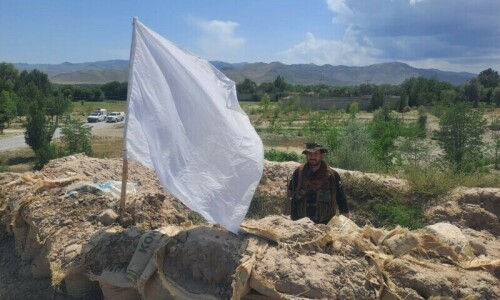KARACHI, Jan 29: The construction of an additional block on the Sindh Assembly premises is likely to suffer delays follwoing the federal government’s recent advice to the provincial caretaker set-up for a major slash in the annual development plan.
Sources close to the finance department told Dawn that the provincial government would not be able to allocate over Rs1.939 billion, which was the project’s estimated cost, if the new annual development plan was prepared in the light of the federal government advice.
The present size of Annual Development Plan of Sindh is Rs50 billion which is being generated by the provincial government from its own resources. Sources said that the provincial government had been asked to restrict the ADP to Rs26.2 billion this year.
Federal (caretaker) Minister for Finance Salman Shah during his visit to the metropolis last month had told the Sindh government high-ups, including the chief secretary, that the trend of increasing the ADP was contrary to the principles of macro economics and the International Monetary Fund (IMF) had objected to it.
He informed them that the federal government had to cut its Public Sector Development Programme by Rs60 billion from Rs520 billion to keep budget indicators in line with the IMF target of restricting the fiscal deficit to four per cent of the Gross Domestic Product.
In this situation, it is feared that the provincial government will not be able to allocate over Rs1.939 billion to meet the present estimated cost of the project. The project’s initial cost was calculated around Rs600 million. However, the delays have already caused an increase of millions of rupees in the estimated outlay of the project.
The PC-I prepared for the additional block of the assembly building had indicated 6.5 per cent increase in the construction cost in the year 2008-2009 and 13 per cent in 2009-2010 when the building is likely to complete if the project tender was awarded within the next two months.
Building plan
The new block will comprise basement, ground plus three floors to be linked with old historical building. It will accommodate about 350 members and have provision for further expansion.
Its 28,292-square-foot basement will have a library, a mosque and a parking lot. The ground floor will have chambers, offices, a hall, voting lounges and related facilities. The second floor, covering an area of 40,440 square feet, will be reserved for rooms of ministers. The third floor will have conference rooms, a gallery and an auditorium besides additional provision of rooms for ministers.
Though the foundation stone of the additional block was laid by former chief minister Dr Arbab Ghulam Rahim on August 31, 2007, construction work had not been initiated since then.
National monument
The original Sindh Assembly building was constructed in a span of two years after its foundation stone was laid on March 11, 1940.
In view of the historical role played by the Sindh Assembly, where the first resolution for the creation of a separate Muslim state - Pakistan - was passed, the Sindh government had decided in 1991 to preserve it as a national monument after the construction of an additional block in its backyard. It is the very same assembly building where Lord Mountbatten had signed the document of transfer of power from the British Raj to Quaid-i-Azam Mohammad Ali Jinnah as the first governor-general of Pakistan.
However, even after finalisation of the building plan in the early 90s the project could not make any progress for three years mainly because of a controversy over the project’s supervisory power between the works department and services and general administration department of the provincial government, said Sindh Assembly Secretary Hadi Bukhsh Buriro.
The issue was resolved only after the project was handed over to the assembly secretariat. Despite approval of its PC-I and its mention in the budget document of 1996, former chief minister late Abdullah Shah dropped the project and decided to acquire 20,000 acres in Malir and shift the assembly and secretariat offices of the Sindh government there.
Project revived
With the installation of a new government in 2002, the old project was revived and the plan was revised to keep provision for future expansion of the seats from present 168 to 350.
The foundation ceremony of the project was scheduled to coincide with the last year’s Independence Day celebrations, but the former chief minister left for Saudi Arabia to perform Umra in the meanwhile and the ceremony was postponed. Finally, the foundation stone of the additional block was laid on August 31, 2007. Since then, construction work could not be initiated.
It is feared that not only the construction cost will be escalated further but the project may also hit snags once again if the required amount was not allocated for the building in the ADP of fiscal year 2008-09.














































